Mokanarangan Thayaparan
Utilizing Multilingual Encoders to Improve Large Language Models for Low-Resource Languages
Aug 12, 2025Abstract:Large Language Models (LLMs) excel in English, but their performance degrades significantly on low-resource languages (LRLs) due to English-centric training. While methods like LangBridge align LLMs with multilingual encoders such as the Massively Multilingual Text-to-Text Transfer Transformer (mT5), they typically use only the final encoder layer. We propose a novel architecture that fuses all intermediate layers, enriching the linguistic information passed to the LLM. Our approach features two strategies: (1) a Global Softmax weighting for overall layer importance, and (2) a Transformer Softmax model that learns token-specific weights. The fused representations are mapped into the LLM's embedding space, enabling it to process multilingual inputs. The model is trained only on English data, without using any parallel or multilingual data. Evaluated on XNLI, IndicXNLI, Sinhala News Classification, and Amazon Reviews, our Transformer Softmax model significantly outperforms the LangBridge baseline. We observe strong performance gains in LRLs, improving Sinhala classification accuracy from 71.66% to 75.86% and achieving clear improvements across Indic languages such as Tamil, Bengali, and Malayalam. These specific gains contribute to an overall boost in average XNLI accuracy from 70.36% to 71.50%. This approach offers a scalable, data-efficient path toward more capable and equitable multilingual LLMs.
A Differentiable Integer Linear Programming Solver for Explanation-Based Natural Language Inference
Apr 03, 2024Abstract:Integer Linear Programming (ILP) has been proposed as a formalism for encoding precise structural and semantic constraints for Natural Language Inference (NLI). However, traditional ILP frameworks are non-differentiable, posing critical challenges for the integration of continuous language representations based on deep learning. In this paper, we introduce a novel approach, named Diff-Comb Explainer, a neuro-symbolic architecture for explanation-based NLI based on Differentiable BlackBox Combinatorial Solvers (DBCS). Differently from existing neuro-symbolic solvers, Diff-Comb Explainer does not necessitate a continuous relaxation of the semantic constraints, enabling a direct, more precise, and efficient incorporation of neural representations into the ILP formulation. Our experiments demonstrate that Diff-Comb Explainer achieves superior performance when compared to conventional ILP solvers, neuro-symbolic black-box solvers, and Transformer-based encoders. Moreover, a deeper analysis reveals that Diff-Comb Explainer can significantly improve the precision, consistency, and faithfulness of the constructed explanations, opening new opportunities for research on neuro-symbolic architectures for explainable and transparent NLI in complex domains.
Going Beyond Approximation: Encoding Constraints for Explainable Multi-hop Inference via Differentiable Combinatorial Solvers
Aug 05, 2022
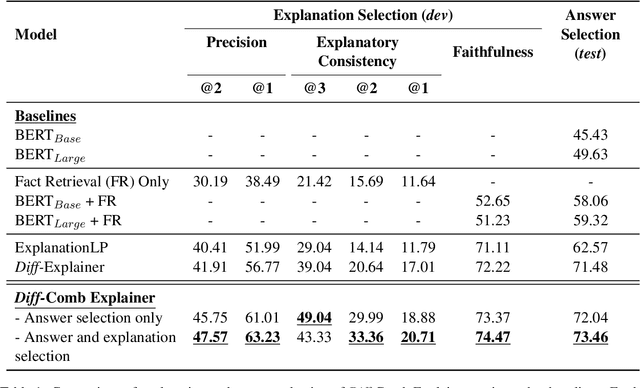

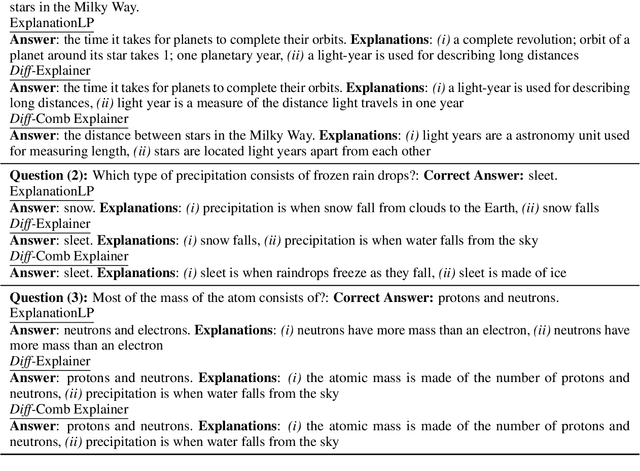
Abstract:Integer Linear Programming (ILP) provides a viable mechanism to encode explicit and controllable assumptions about explainable multi-hop inference with natural language. However, an ILP formulation is non-differentiable and cannot be integrated into broader deep learning architectures. Recently, Thayaparan et al. (2021a) proposed a novel methodology to integrate ILP with Transformers to achieve end-to-end differentiability for complex multi-hop inference. While this hybrid framework has been demonstrated to deliver better answer and explanation selection than transformer-based and existing ILP solvers, the neuro-symbolic integration still relies on a convex relaxation of the ILP formulation, which can produce sub-optimal solutions. To improve these limitations, we propose Diff-Comb Explainer, a novel neuro-symbolic architecture based on Differentiable BlackBox Combinatorial solvers (DBCS) (Pogan\v{c}i\'c et al., 2019). Unlike existing differentiable solvers, the presented model does not require the transformation and relaxation of the explicit semantic constraints, allowing for direct and more efficient integration of ILP formulations. Diff-Comb Explainer demonstrates improved accuracy and explainability over non-differentiable solvers, Transformers and existing differentiable constraint-based multi-hop inference frameworks.
Hybrid Autoregressive Solver for Scalable Abductive Natural Language Inference
Jul 25, 2021



Abstract:Regenerating natural language explanations for science questions is a challenging task for evaluating complex multi-hop and abductive inference capabilities. In this setting, Transformers trained on human-annotated explanations achieve state-of-the-art performance when adopted as cross-encoder architectures. However, while much attention has been devoted to the quality of the constructed explanations, the problem of performing abductive inference at scale is still under-studied. As intrinsically not scalable, the cross-encoder architectural paradigm is not suitable for efficient multi-hop inference on massive facts banks. To maximise both accuracy and inference time, we propose a hybrid abductive solver that autoregressively combines a dense bi-encoder with a sparse model of explanatory power, computed leveraging explicit patterns in the explanations. Our experiments demonstrate that the proposed framework can achieve performance comparable with the state-of-the-art cross-encoder while being $\approx 50$ times faster and scalable to corpora of millions of facts. Moreover, we study the impact of the hybridisation on semantic drift and science question answering without additional training, showing that it boosts the quality of the explanations and contributes to improved downstream inference performance.
Supporting Context Monotonicity Abstractions in Neural NLI Models
May 17, 2021

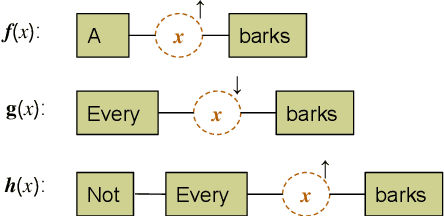

Abstract:Natural language contexts display logical regularities with respect to substitutions of related concepts: these are captured in a functional order-theoretic property called monotonicity. For a certain class of NLI problems where the resulting entailment label depends only on the context monotonicity and the relation between the substituted concepts, we build on previous techniques that aim to improve the performance of NLI models for these problems, as consistent performance across both upward and downward monotone contexts still seems difficult to attain even for state-of-the-art models. To this end, we reframe the problem of context monotonicity classification to make it compatible with transformer-based pre-trained NLI models and add this task to the training pipeline. Furthermore, we introduce a sound and complete simplified monotonicity logic formalism which describes our treatment of contexts as abstract units. Using the notions in our formalism, we adapt targeted challenge sets to investigate whether an intermediate context monotonicity classification task can aid NLI models' performance on examples exhibiting monotonicity reasoning.
$\partial$-Explainer: Abductive Natural Language Inference via Differentiable Convex Optimization
May 07, 2021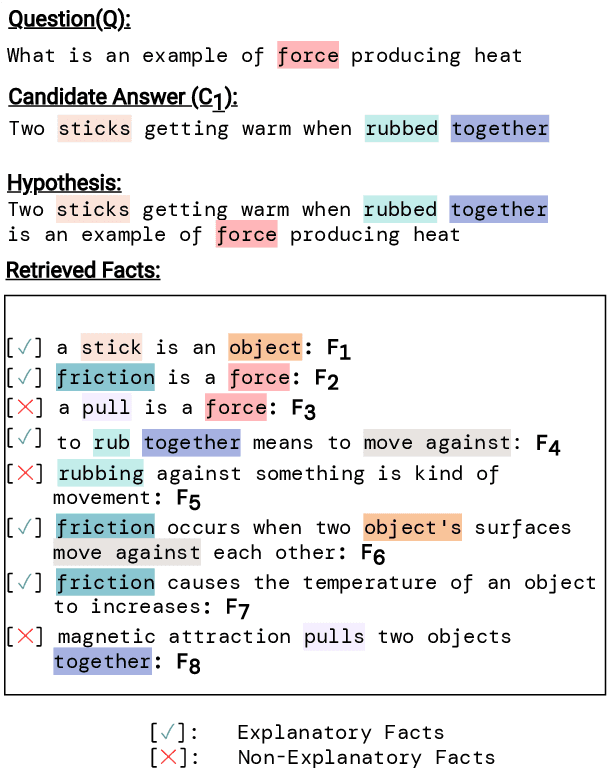



Abstract:Constrained optimization solvers with Integer Linear programming (ILP) have been the cornerstone for explainable natural language inference during its inception. ILP based approaches provide a way to encode explicit and controllable assumptions casting natural language inference as an abductive reasoning problem, where the solver constructs a plausible explanation for a given hypothesis. While constrained based solvers provide explanations, they are often limited by the use of explicit constraints and cannot be integrated as part of broader deep neural architectures. In contrast, state-of-the-art transformer-based models can learn from data and implicitly encode complex constraints. However, these models are intrinsically black boxes. This paper presents a novel framework named $\partial$-Explainer (Diff-Explainer) that combines the best of both worlds by casting the constrained optimization as part of a deep neural network via differentiable convex optimization and fine-tuning pre-trained transformers for downstream explainable NLP tasks. To demonstrate the efficacy of the framework, we transform the constraints presented by TupleILP and integrate them with sentence embedding transformers for the task of explainable science QA. Our experiments show up to $\approx 10\%$ improvement over non-differentiable solver while still providing explanations for supporting its inference.
Switching Contexts: Transportability Measures for NLP
May 03, 2021



Abstract:This paper explores the topic of transportability, as a sub-area of generalisability. By proposing the utilisation of metrics based on well-established statistics, we are able to estimate the change in performance of NLP models in new contexts. Defining a new measure for transportability may allow for better estimation of NLP system performance in new domains, and is crucial when assessing the performance of NLP systems in new tasks and domains. Through several instances of increasing complexity, we demonstrate how lightweight domain similarity measures can be used as estimators for the transportability in NLP applications. The proposed transportability measures are evaluated in the context of Named Entity Recognition and Natural Language Inference tasks.
Does My Representation Capture X? Probe-Ably
Apr 12, 2021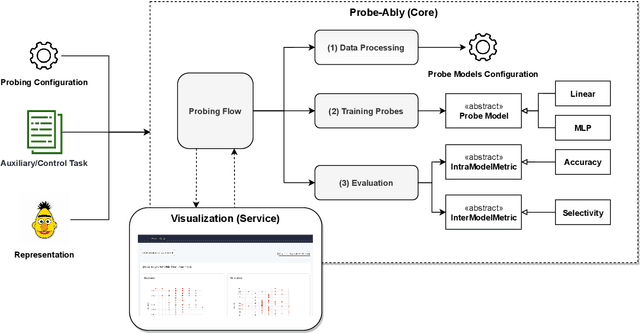
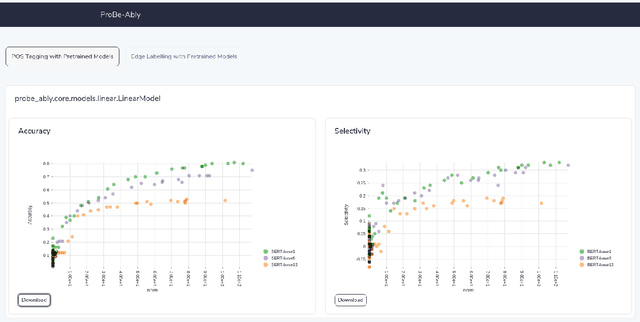

Abstract:Probing (or diagnostic classification) has become a popular strategy for investigating whether a given set of intermediate features is present in the representations of neural models. Naive probing studies may have misleading results, but various recent works have suggested more reliable methodologies that compensate for the possible pitfalls of probing. However, these best practices are numerous and fast-evolving. To simplify the process of running a set of probing experiments in line with suggested methodologies, we introduce Probe-Ably: an extendable probing framework which supports and automates the application of probing methods to the user's inputs
ExplanationLP: Abductive Reasoning for Explainable Science Question Answering
Oct 25, 2020
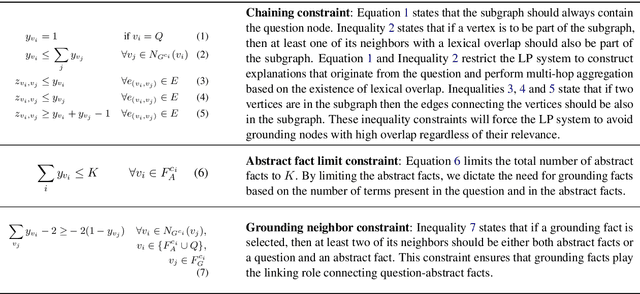
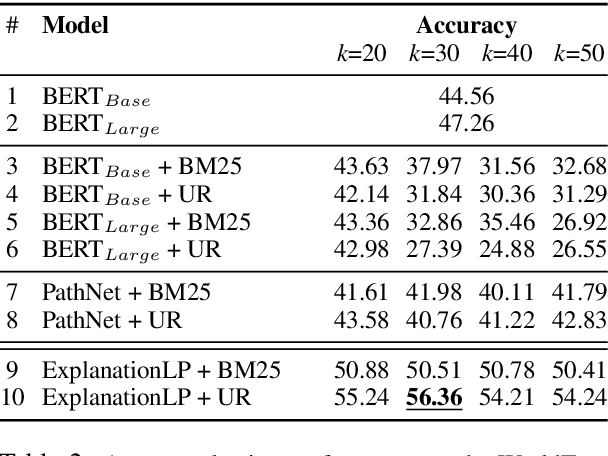

Abstract:We propose a novel approach for answering and explaining multiple-choice science questions by reasoning on grounding and abstract inference chains. This paper frames question answering as an abductive reasoning problem, constructing plausible explanations for each choice and then selecting the candidate with the best explanation as the final answer. Our system, ExplanationLP, elicits explanations by constructing a weighted graph of relevant facts for each candidate answer and extracting the facts that satisfy certain structural and semantic constraints. To extract the explanations, we employ a linear programming formalism designed to select the optimal subgraph. The graphs' weighting function is composed of a set of parameters, which we fine-tune to optimize answer selection performance. We carry out our experiments on the WorldTree and ARC-Challenge corpus to empirically demonstrate the following conclusions: (1) Grounding-Abstract inference chains provides the semantic control to perform explainable abductive reasoning (2) Efficiency and robustness in learning with a fewer number of parameters by outperforming contemporary explainable and transformer-based approaches in a similar setting (3) Generalisability by outperforming SOTA explainable approaches on general science question sets.
A Survey on Explainability in Machine Reading Comprehension
Oct 01, 2020



Abstract:This paper presents a systematic review of benchmarks and approaches for explainability in Machine Reading Comprehension (MRC). We present how the representation and inference challenges evolved and the steps which were taken to tackle these challenges. We also present the evaluation methodologies to assess the performance of explainable systems. In addition, we identify persisting open research questions and highlight critical directions for future work.
 Add to Chrome
Add to Chrome Add to Firefox
Add to Firefox Add to Edge
Add to Edge